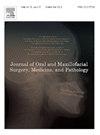涎腺及口腔黏膜按摩对缓解精神分裂症患者口干症的疗效观察
IF 0.4
Q4 DENTISTRY, ORAL SURGERY & MEDICINE
Journal of Oral and Maxillofacial Surgery Medicine and Pathology
Pub Date : 2024-11-30
DOI:10.1016/j.ajoms.2024.11.011
引用次数: 0
摘要
目的探讨涎腺及口腔黏膜按摩对缓解精神分裂症患者抗精神病药物不良反应口干症的疗效,探讨影响其疗效的相关因素,明确其适应证。方法将47例慢性精神分裂症患者随机分为干预组和对照组。干预组接受唾液腺及口腔黏膜按摩,随访至第8周。对照组分别在基线和8周后进行评估。结果共30例患者完成研究,其中干预组15例,对照组15例。干预组8周后,口香糖试验刺激的唾液流量明显增加。此外,第一代抗精神病药(FGA)等价物在唾腺口腔粘膜按摩后唾液流率不变的患者中的使用率明显高于表现出改善的患者。与单独使用SGA的患者相比,使用第二代抗精神病药物(SGAs)和FGAs的患者对唾液分泌增加的倾向的认知程度较低,大多数使用左旋丙嗪,这是一种具有高毒蕈碱受体亲和力的FGA。结论涎腺及口腔黏膜按摩可促进慢性精神分裂症患者的唾液分泌。FGA的摄入抑制了按摩的效果,而左旋丙嗪可能影响了这种抑制作用。了解左旋丙嗪与唾液腺和口腔黏膜按摩的相互作用可以改善慢性精神分裂症的治疗策略和患者护理。本文章由计算机程序翻译,如有差异,请以英文原文为准。
Effectiveness of salivary-gland and oral-mucosa massage in alleviating xerostomia in patients with schizophrenia
Objective
To investigate the effectiveness of salivary-gland and oral-mucosa massage in alleviating xerostomia, which is an adverse effect of antipsychotics, in patients with schizophrenia and to investigate factors associated with its efficacy and clarify its indications.
Methods
In this randomized controlled trial, 47 patients with chronic schizophrenia were randomly divided into the intervention and control groups. The intervention group underwent salivary-gland and oral-mucosa massage and was followed up from baseline to week 8. The control group was assessed at baseline and after 8 weeks.
Results
Overall, 30 patients completed the study (15 in the intervention group and 15 in the control group). In the intervention group, the salivary flow rate stimulated by the chewing gum test significantly increased after 8 weeks. Furthermore, the use of first-generation antipsychotic (FGA) equivalents was significantly higher in patients whose salivary flow rate was unchanged after salivary gland oral-mucosal massage than in patients who showed improvement. Compared with the patients who used SGA alone, those who used second-generation antipsychotics (SGAs) and FGAs had less recognition of the tendency for salivary secretion to increase, and most of them used levomepromazine, an FGA with high muscarinic receptor affinity.
Conclusions
Salivary-gland and oral-mucosa massage may promote salivation in patients with chronic schizophrenia. FGA intake inhibited the effects of the massage, and levomepromazine may have influenced this inhibition. Understanding the interactions between levomepromazine and salivary-gland and oral-mucosa massage can improve treatment strategies and patient care in chronic schizophrenia.
求助全文
通过发布文献求助,成功后即可免费获取论文全文。
去求助
来源期刊

Journal of Oral and Maxillofacial Surgery Medicine and Pathology
DENTISTRY, ORAL SURGERY & MEDICINE-
CiteScore
0.80
自引率
0.00%
发文量
129
审稿时长
83 days
 求助内容:
求助内容: 应助结果提醒方式:
应助结果提醒方式:


